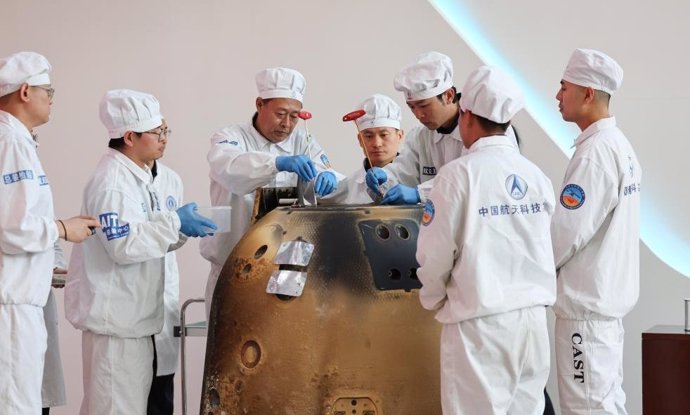Opening of Chang’e 6 sample container – XINHUA/CNSA
June 28 () –
China’s Chang’e-6 mission collected 1,935.3 grams of samples from the dark side of the Moonaccording to the weighing of the container that arrived on Earth on June 25.
“We have discovered that the samples brought back by Chang’e-6 were more viscous compared to the previous samples, with the presence of lumps. “These are observable characteristics,” said Ge Ping, deputy director of the Lunar Exploration and Space Engineering Center of the CNSA (China National Space Administration), who is also the spokesman for the Chang’e-6 mission.
The researchers will then carry out the storage and processing of the lunar samples as planned and start scientific research work, Xinhua reports.
Lunar samples, which were collected from the far side of the moon for the first time in human history, They have unique scientific significance as they will further enhance the understanding of lunar evolution, accelerate the pace of peaceful exploration and utilization of lunar resources, and serve as an important asset for all of humanity, the CNSA said.
The CNSA said it will organize scientific research on the samples and share China’s lunar exploration achievements with the international community.
Based on the lunar sample management rules published by the CNSA and the experience in handling requests for lunar samples collected by the Chang’e-5 mission, it is expected that requests for Chang’e-6 samples will be open to domestic research institutions and scientists in about six months, Ge said.
Regarding international applications, Ge noted that China has always maintained a positive and open attitude and China welcomes scientists from all countries to submit applications in accordance with relevant procedures.
Previously, significant scientific achievements have been made through in-depth research on lunar samples brought back by the Chang’e-5 mission, in areas such as lunar formation and evolution, space weathering and resource utilization, the CNSA said.
Researchers have published more than 80 studies in national and international journals, including the discovery of the new lunar mineral Changesite-(Y), the sixth discovered on the Moon, and the “youngest” basalt on the Moon, which was determined to have about two billion years and extended the “life” of lunar volcanism by 800 to 900 million years longer than previously known.
The Chang’e-6 probe was launched into orbit on May 3.. Its return module, carrying the lunar samples, landed precisely in its designated area in north China’s Inner Mongolia Autonomous Region on June 25, marking a complete success for the mission.
The Chang’e-6 return module arrived safely in Beijing later. Researchers opened it and successfully collected the lunar sample container on Wednesday, according to the CNSA. ¦







![[Img #74853]](https://thelatestnews.world/wp-content/uploads/2025/01/Beginners-Guide-to-iGaming-150x150.jpg)


![[Img #74853]](https://thelatestnews.world/wp-content/uploads/2025/01/Beginners-Guide-to-iGaming-300x200.jpg)


Add Comment